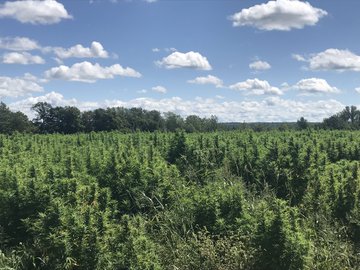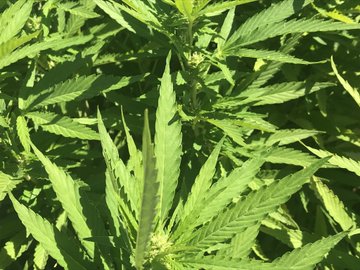Western New York farmers preparing to harvest first hemp crop | wgrz.com
- Get link
- X
- Other Apps
Western New York farmers preparing to harvest first hemp crop | wgrz.com
BUSINESS
Western New York farmers preparing to harvest first hemp crop
Though cultivated for centuries, the growing demand for hemp oil to make CBD products has farmers taking a chance on what they hope will be a new cash crop.
Author: Dave McKinley
Published: 7:52 PM EDT August 29, 2019
Updated: 11:38 PM EDT August 29, 2019
EDEN, N.Y. — Amos Zittel and Sons Inc. is known far and wide for the variety and quality of crops it produces in the fertile soils in the Eden Valley of Western New York.
But among the usual cornucopia of cucumbers, tomatoes, and peppers it has been turning out for four generations, along with its sizable greenhouse operation for plants and flowers, a new endeavor is underway.
Among the 300 acres the Zittel’s work stands 18 acres of what looks to the untrained eye like fields of marijuana.
It is actually hemp, just weeks away from first harvest.
According to Bill Zittel, who is spearheading the family’s first foray into producing it, hemp has seen a resurgence to meet the growing demand for CBD products.
“I think that might be where the opportunity might be going, toward medicinal use,” Zittel said.
See Dave McKinley's other Tweets
No easy row to hoe
It turns out the soil here, which is so good for producing so many other crops, is also well-suited for hemp.
“You have to have well-drained soil, which we are fortunate to have … but it does also require a lot of water. So if you don’t have an infrastructure where you can irrigate it, you shouldn’t try growing it,” Zittel said.
However, despite them having the elements necessary and decades of expertise in growing plants, like many other things when it comes to farming, that won’t make it easy.
First, it is extremely labor-intensive.
When asked what kind of combine or harvesting machinery they might utilize to bring in the crop, Zittel laughed and held up his hands.
“You’re looking at them,” he said with a laugh.
The entire crop will be cut by hand, by means which Zittel, though the harvest is near, is not entirely certain.
Noting the thick stem of the hemp plants (some of which are about the size of a human wrist in circumference) he surmised they might try to attach a blade to a weed whacker, or arm their laborers with cordless reciprocating saws normally used by carpenters.
And that’s just for starters.
“We will then have to hang it and dry it, and then (also by hand) do something that’s called ‘bucking,' where we pull the leaves and the buds off,” Zittel said.
The buds, he further explained, are what gets sent off to a processor for "juicing," the means by which the oils are extracted.
Risky business
Farming by its very nature is fraught with risk.
From the time seeds are sown in the spring, and money is expended for fuel, fertilizer and labor, it can be crap-shoot due to circumstances well beyond a farmer’s control, not the least of which is the weather.
Thus, when it comes to commodities, a farmer cannot be certain as to how lucrative a crop may be.
The price it brings in all depends on the quantity, quality, and market rate. Hemp is no different in that regard, which is why Zittel can’t project at this point whether hemp will be a worthwhile endeavor.
Beyond that, there is something in particular about hemp that a farmer has to be carefully aware.
“You have to have all feminized plants out here. If you have one male in your field, you have a chance of cutting the wealth of your crop in half or more," said Zittel, explaining that the presence of male plants will cause the crop to go to seed instead of flower.
“We had to make sure that out of our 50,000 plants, there was not one male plant among them,” he said.
According to Zittel, seed producers have sophisticated methods, including machines, designed to distinguish seeds between male and female, and which can produce batches containing only one male seed per thousand.
Even there however, the grower must be wary.
“That’s still not 100 percent so that could potentially ruin a whole crop,” Zittel said.
Hemp is grown under strict guidelines
Hemp is grown under strict guidelines
As if the challenges of growing hemp aren’t daunting enough, farmers must obtain a license to grow it under strict guidelines.
"Everything has to be tested before it can be harvested and it has to have less than 0.3% THC, and anything over that you can’t harvest it," said Zittel, referring to the psychoactive component of cannabis, which hemp is a strain of.
In fact, according to a report in the Honolulu Star-Advertiser published Monday, more than half of hemp crops cultivated in Hawaii in the past year were unusable due to high THC levels, when they tested above the federal limit for the chemical that causes people to become high.
The crop had to be destroyed.
No buzz in these buds
This also means that someone who uses marijuana recreationally and who might come across the hemp fields now flourishing in the Eden Valley (and who might think they just hit the jackpot) might be disappointed to find that there's no buzz in these buds.
“The THC levels are so low that it wouldn’t do anything for them along the lines of the high they might experience from marijuana,” Zittle said.
Nonetheless, anticipating that the sight of what appears to be large fields of marijuana might cause a passing law enforcement officer to take more than a sideways glance, Zittle told 2 On Your Side. “I took it upon myself to notify our local police department and tell them exactly what we were doing.”
- Get link
- X
- Other Apps



Comments
Post a Comment